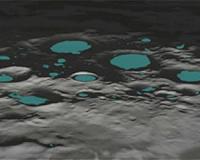 |
Washington DC (SPX) Jun 17, 2010 Scientists at the Carnegie Institution's Geophysical Laboratory, with colleagues, have discovered a much higher water content in the Moon's interior than previous studies. Their research suggests that the water, which is a component of the lunar rocks, was preserved from the hot magma that was present when the Moon began to form some 4.5 billion years ago, and that it is likely widespread in the Moon's interior. "For over 40 years we thought the Moon was dry. The bulk water content of the Moon was estimated to be less than 1 ppb, which would make the Moon at least six orders of magnitude drier than the interiors of Earth and Mars," remarked lead author Francis McCubbin. "In our study we looked at hydroxyl in the mineral apatite-the only hydrous mineral in the assemblage of minerals we examined in two Apollo samples and a lunar meteorite. Summarizing his team's method and results, McCubbin explained, "In the lab of colleague Erik Hauri at Carnegie's Department of Terrestrial Magnetism, we used secondary ion mass spectrometry (SIMS), which can detect elements in the parts per million range and combining these measurements with models that characterize how the material crystallized as the Moon cooled during formation, we found that the minimum water content ranged from 64 parts per billion to 5 parts per million-at least two orders of magnitude greater than previous results." The prevailing belief is that the Moon came from a giant-impact event, when a Mars-sized object hit the Earth and the ejected material coalesced into the Moon. From two of the samples, the Carnegie scientists determined that water was likely present very early in the formation history as the hot magma started to cool and crystallize. This result means that water is native to the Moon. The previous studies showing water on the Moon analyzed volcanic glasses. These researchers looked within KREEP-rich rocks. KREEP comes from the last stages of crystallization. KREEP rocks contain more potassium (K), rare Earth elements (REE), phosphorus (P), and other heat-producing elements such as uranium and thorium. "Since water is insoluble in the main silicates that crystallized, we believed that it should have concentrated in the KREEP," explained coauthor Andrew Steele. "That's why we selected it to analyze." The researchers specifically studied hydroxyl, a compound with an oxygen atom bound with hydrogen, in the mineral apatite-the only hydrous mineral in the assemblage. After initial analyses, the scientists excluded one of the Apollo samples from further study because it was unlikely to yield good information about magmatic water content. They concentrated on the other Apollo sample and the lunar meteorite to determine water in the lunar interior. "It is gratifying to see this proof of the OH contents in lunar apatite," remarked lunar scientist Bradley Jolliff of Washington University in St. Louis. "The concentrations are very low and, accordingly, they have been until recently nearly impossible to detect. We can now finally begin to consider the implications-and the origin-of water in the interior of the Moon."
Share This Article With Planet Earth
Related Links Carnegie Institution Mars News and Information at MarsDaily.com Lunar Dreams and more
 Water Content Of Moon's Interior Underestimated
Water Content Of Moon's Interior UnderestimatedWashington DC (SPX) Jun 15, 2010 NASA-funded scientists estimate from recent research that the volume of water molecules locked inside minerals in the moon's interior could exceed the amount of water in the Great Lakes here on Earth. Scientists at the Carnegie Institution's Geophysical Laboratory in Washington, along with other scientists across the nation, determined that the water was likely present very early in the mo ... read more |
|
| The content herein, unless otherwise known to be public domain, are Copyright 1995-2010 - SpaceDaily. AFP and UPI Wire Stories are copyright Agence France-Presse and United Press International. ESA Portal Reports are copyright European Space Agency. All NASA sourced material is public domain. Additional copyrights may apply in whole or part to other bona fide parties. Advertising does not imply endorsement,agreement or approval of any opinions, statements or information provided by SpaceDaily on any Web page published or hosted by SpaceDaily. Privacy Statement |